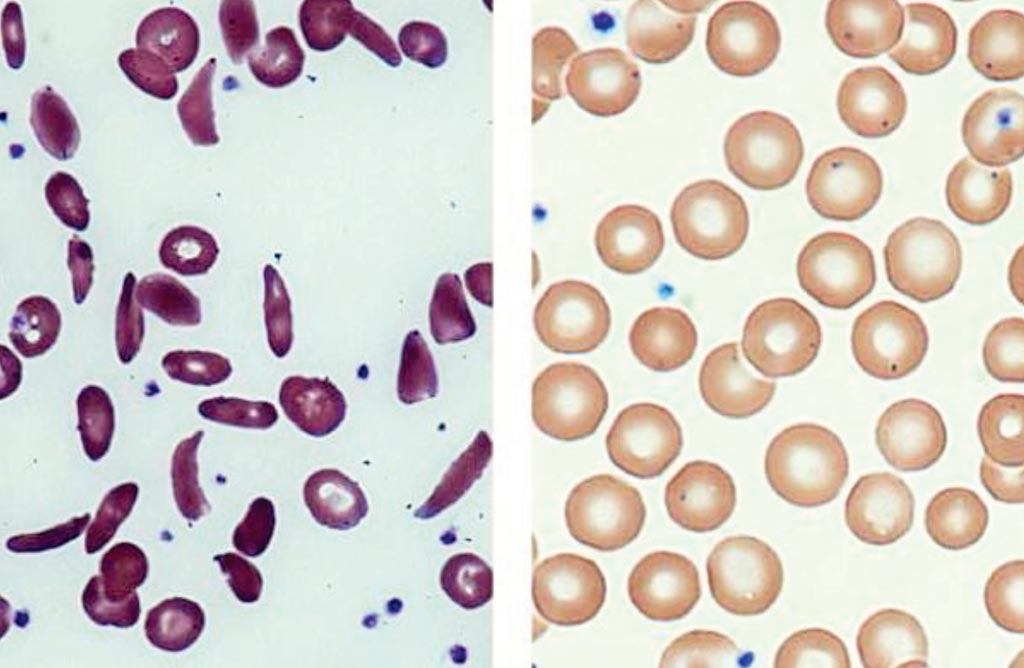Allogeneic Transplantation Outcomes Compared in Sickle Cell Disease Patients
By LabMedica International staff writers
Posted on 06 Nov 2019
Sickle cell disease is a group of disorders that affects hemoglobin, the molecule in red blood cells that delivers oxygen to cells throughout the body. People with this disorder have atypical hemoglobin molecules called hemoglobin S, which can distort red blood cells into a sickle, or crescent, shape.Posted on 06 Nov 2019
Hematopoietic stem cell transplantation (HSCT) involves the intravenous infusion of autologous or allogeneic stem cells collected from bone marrow, peripheral blood, or umbilical cord blood to reestablish hematopoietic function in patients whose bone marrow or immune system is damaged or defective. Donors other than matched siblings and low-intensity conditioning regimens are increasingly used in HSCT.

Image: Blood drawn from a sickle cell patient (left) and from a patient after stem-cell transplant (right) (Photo courtesy of NIH Molecular and Clinical Hematology Branch).
Hematologists at the Medical College of Wisconsin (Milwaukee, WI, USA) and their associates aimed to compare the relative risk of donor type and conditioning regimen intensity on the transplantation outcomes of in patients with sickle cell disease. They collected data from 90 centers in the USA. Eligible patients were younger than 50 years, had genetically confirmed sickle cell disease (Hb SS) or sickle beta thalassemia (Hb Sβ), and underwent allogeneic hematopoietic cell transplantation between January 15, 2008, and December 28, 2017.
The team considered transplants from donor-recipient pairs matched at the allele-level (HLA-A, HLA-B, HLA-C, and HLA-DRB1), including HLA-matched sibling donors, haploidentical related donors, matched unrelated donors, or mismatched unrelated donors. The main outcome was event-free survival. The effect of donor type, conditioning regimen intensity (myeloablative, non-myeloablative, and reduced-intensity regimens), age (≤12 or 13-49 years), sex, performance score, comorbidity index, recipient cytomegalovirus serostatus, graft type (bone marrow, peripheral blood, or umbilical cord blood), and transplantation period (2008–12 and 2013–17) on outcomes.
The scientists reported that of 996 patients with sickle cell disease and who underwent transplantation in 2008–17, 910 (91%) were included (558 [61%] patients had HLA-matched sibling donors, 137 [15%] haploidentical related donors, 111 [12%] matched unrelated donors, and 104 [11%] mismatched unrelated donors). The median follow-up was 36 months (IQR 18–60) after transplantation from HLA-matched siblings, 25 months (12–48) after transplantation from haploidentical related donors, 37 months (23–60) after transplantation from HLA-matched unrelated donors, and 47 months (24–72) after transplantation from mismatched unrelated donors.
Event-free survival was worse in recipients aged 13 years or older than in those younger than 13 years (hazard ratio [HR] = 1.74) and in those who received a transplant from haploidentical related donors (HR = 5.30), matched unrelated donors (HR = 3.71) and mismatched unrelated donors (HR = 4.34) than in patients who received a transplant from matched siblings. Event-free survival was also worse in patients conditioned with reduced-intensity regimens than in those conditioned with non-myeloablative regimens, but did not differ between those who received myeloablative compared with non-myeloablative regimens.
The authors concluded that their data suggests that event-free survival is improved in patients with sickle cell disease who receive an allogenic transplantation at age 12 years or younger and those with an HLA-matched sibling donor. For patients without a matched sibling available for transplantation, the data did not favor one alternative donor type over another in this setting. The study was published on November 1, 2019, in the journal Lancet Haematology.
Related Links:
Medical College of Wisconsin







 Analyzer.jpg)





